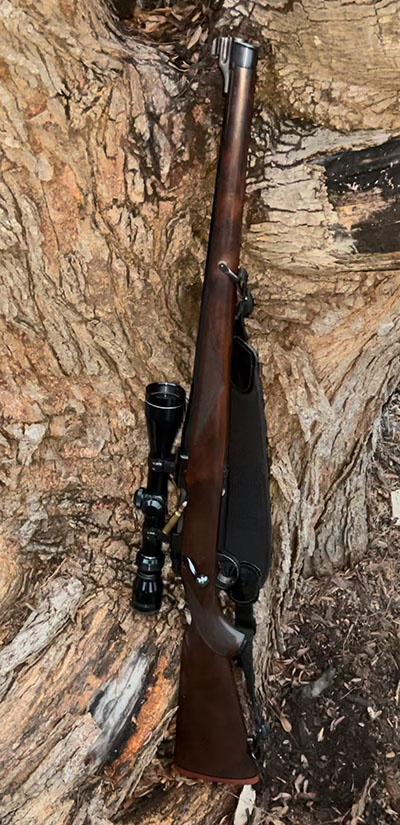
THE RUGER INTERNATIONAL RIFLE in .250-3000 caliber is a delight to shoot and is highly effective on game up to the size of Texas deer. The cartridge leaning on the ejection port is a 100-grain round that is the one primarily used for deer hunting. An 87-grain round is an excellent varmint cartridge. And February is the recommended month for hunting coyotes, bobcats, and foxes. At close distance, the camera distorted the rifle, making the carbine appear longer. (Photo by John and Vicky Jefferson)
by John Jefferson
A good friend from whom I had a deer lease for eleven years emailed me asking if I owned a .250 Savage rifle. I replied I had owned two, and still have one with which our entire family loves to hunt. It’s put over a thousand pounds of venison and other game on our dinner table.
He hasn’t replied yet, but it’s not for sale.
Most shooters are not familiar with it, but a few are. It became out of date and production after the Big War when the .243 Winchester and other small caliber cartridges became popular.
I found one in a gun shop in Leander that had a scratched up-stock but was priced right. I meticulously re-finished the stock and scoped it. I’ve turned down several offers, each higher than the one before, and seen envy in many appreciative eyes.
My first 16-year-old grandson sighted it in before deer hunting with it. With the first shot, he turned and said, “Gosh, I expected more kick from it.” But low recoil isn’t its only attraction.
When I began deer hunting with my first one in the ‘sixties, several people told me it was a “varmint rifle” at best – not a deer rifle. But a hundred-grain, .25 caliber bullet moving at 2,700 hundred feet per second is a stopper! We’ve never had a deer escape, other than one a family member blew a leg off of at a range longer than estimated. The bullet dropped several inches at that distance.
I never fired a shot at a deer with my first .250-3000, but it captivated me just looking at It hanging on the wall. The fact that it was referred to as “the SAVAGE” may have sparked my imagination a little. It was a beautiful rifle with a deep blue finish and finely checkered stock with a sharp Schnabel forend. That forend is an old German design which I later shaped onto a custom-stocked .30-06. That style’s not popular anymore, but I love its uniqueness.
It also had a tooled leather boot on the butt of the stock, and came with a matching, hand-tooled leather saddle scabbard. I inherited it from my father and grandfather, the latter of whom was E.D. of Texas Game and Fish Commission and had ranched near Lipan Springs in Tom Green County. I have a photo of him on horseback, and in my mind, pictured that scabbard and rifle hanging from his saddle. Both men passed before I could ask about its history.
I began hunting with it but never saw a deer. When sighting it in, the bullet holes were about five inches apart at a hundred yards and unsatisfactory. Upon examination, a pitted bore was the problem. Matching its appearance with a new barrel would have changed its looks.
And it was a piece of art.
Defacing it would have been like painting lipstick on the Mona Lisa. I later sold it along with the leather scabbard to McBride’s Guns.
JJ




